CO4830 IT Project Management: Project Choices, Teamwork & Legalities
VerifiedAdded on 2023/06/13
|12
|2821
|131
Report
AI Summary
This report critically evaluates the choices made in an IT project, focusing on the implementation of a website for Lizzie Leather Belt using the Scrum project management approach. It analyzes the strengths and weaknesses of the project team, highlighting their flexibility, cooperation, and knowledge of project management methodologies, while also addressing their inexperience and reluctance to change. The report further discusses professional and legal issues such as privacy, data breach, risk insurance, and contract management, emphasizing the importance of addressing these aspects for successful project implementation. The project's scheduling, risk management, and code quality are also evaluated, along with the impact of Scrum methodology on project delivery and customer satisfaction. The document emphasizes the significance of proper planning, stakeholder analysis, and risk management in IT project management.

Running head: IT PROJECT MANAGEMENT
IT Project Management
Name of the Student
Name of the University
Author Note
IT Project Management
Name of the Student
Name of the University
Author Note
Paraphrase This Document
Need a fresh take? Get an instant paraphrase of this document with our AI Paraphraser
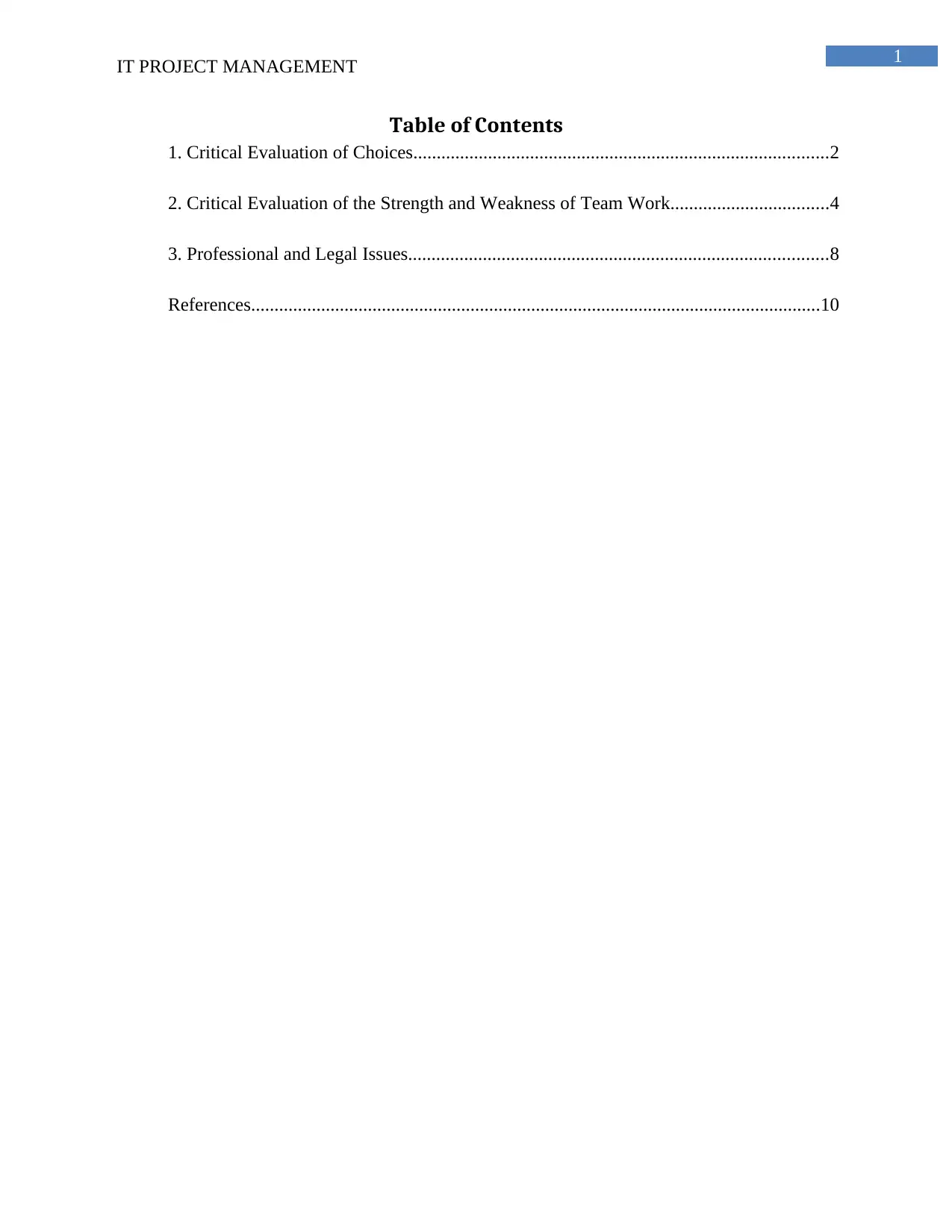
1
IT PROJECT MANAGEMENT
Table of Contents
1. Critical Evaluation of Choices.........................................................................................2
2. Critical Evaluation of the Strength and Weakness of Team Work..................................4
3. Professional and Legal Issues..........................................................................................8
References..........................................................................................................................10
IT PROJECT MANAGEMENT
Table of Contents
1. Critical Evaluation of Choices.........................................................................................2
2. Critical Evaluation of the Strength and Weakness of Team Work..................................4
3. Professional and Legal Issues..........................................................................................8
References..........................................................................................................................10
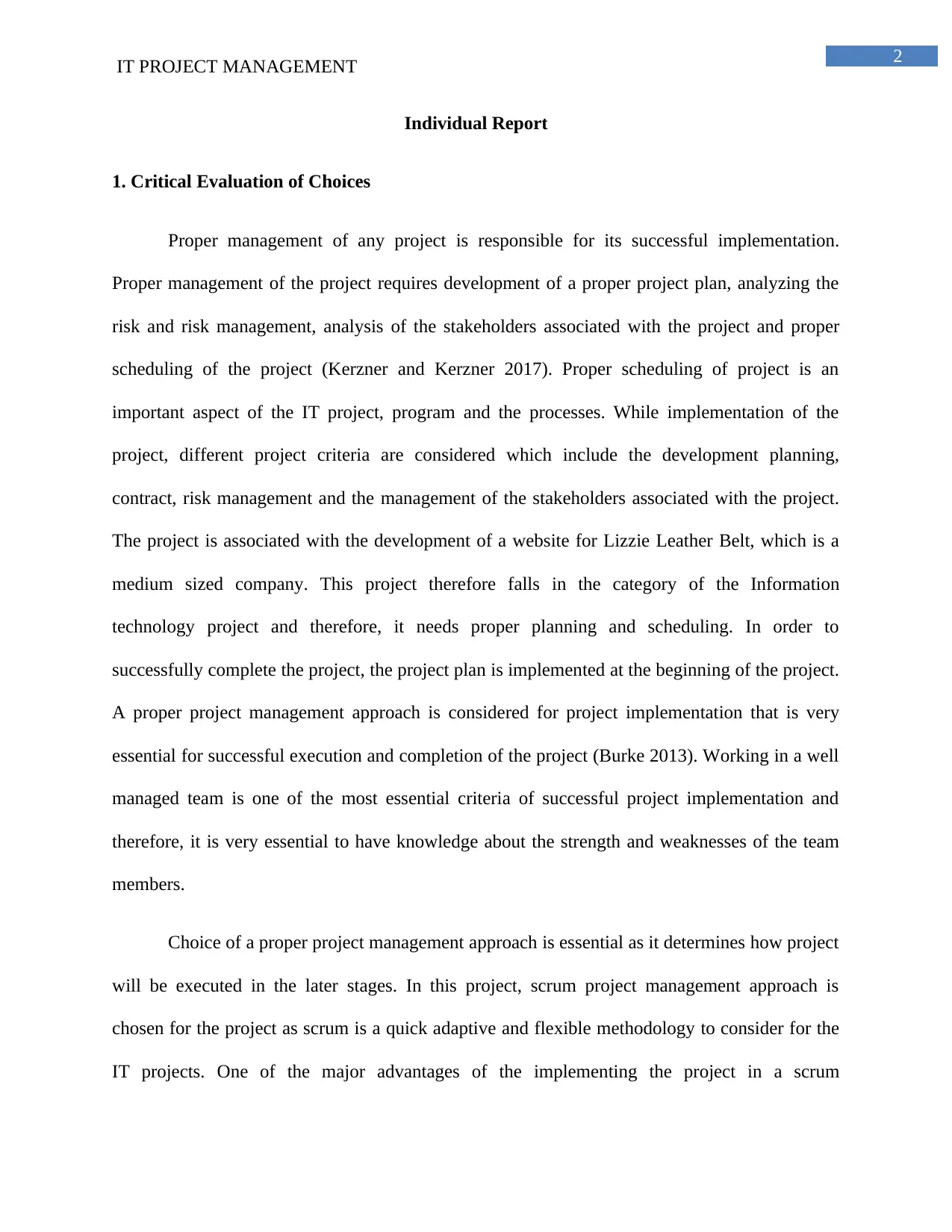
2
IT PROJECT MANAGEMENT
Individual Report
1. Critical Evaluation of Choices
Proper management of any project is responsible for its successful implementation.
Proper management of the project requires development of a proper project plan, analyzing the
risk and risk management, analysis of the stakeholders associated with the project and proper
scheduling of the project (Kerzner and Kerzner 2017). Proper scheduling of project is an
important aspect of the IT project, program and the processes. While implementation of the
project, different project criteria are considered which include the development planning,
contract, risk management and the management of the stakeholders associated with the project.
The project is associated with the development of a website for Lizzie Leather Belt, which is a
medium sized company. This project therefore falls in the category of the Information
technology project and therefore, it needs proper planning and scheduling. In order to
successfully complete the project, the project plan is implemented at the beginning of the project.
A proper project management approach is considered for project implementation that is very
essential for successful execution and completion of the project (Burke 2013). Working in a well
managed team is one of the most essential criteria of successful project implementation and
therefore, it is very essential to have knowledge about the strength and weaknesses of the team
members.
Choice of a proper project management approach is essential as it determines how project
will be executed in the later stages. In this project, scrum project management approach is
chosen for the project as scrum is a quick adaptive and flexible methodology to consider for the
IT projects. One of the major advantages of the implementing the project in a scrum
IT PROJECT MANAGEMENT
Individual Report
1. Critical Evaluation of Choices
Proper management of any project is responsible for its successful implementation.
Proper management of the project requires development of a proper project plan, analyzing the
risk and risk management, analysis of the stakeholders associated with the project and proper
scheduling of the project (Kerzner and Kerzner 2017). Proper scheduling of project is an
important aspect of the IT project, program and the processes. While implementation of the
project, different project criteria are considered which include the development planning,
contract, risk management and the management of the stakeholders associated with the project.
The project is associated with the development of a website for Lizzie Leather Belt, which is a
medium sized company. This project therefore falls in the category of the Information
technology project and therefore, it needs proper planning and scheduling. In order to
successfully complete the project, the project plan is implemented at the beginning of the project.
A proper project management approach is considered for project implementation that is very
essential for successful execution and completion of the project (Burke 2013). Working in a well
managed team is one of the most essential criteria of successful project implementation and
therefore, it is very essential to have knowledge about the strength and weaknesses of the team
members.
Choice of a proper project management approach is essential as it determines how project
will be executed in the later stages. In this project, scrum project management approach is
chosen for the project as scrum is a quick adaptive and flexible methodology to consider for the
IT projects. One of the major advantages of the implementing the project in a scrum
⊘ This is a preview!⊘
Do you want full access?
Subscribe today to unlock all pages.

Trusted by 1+ million students worldwide
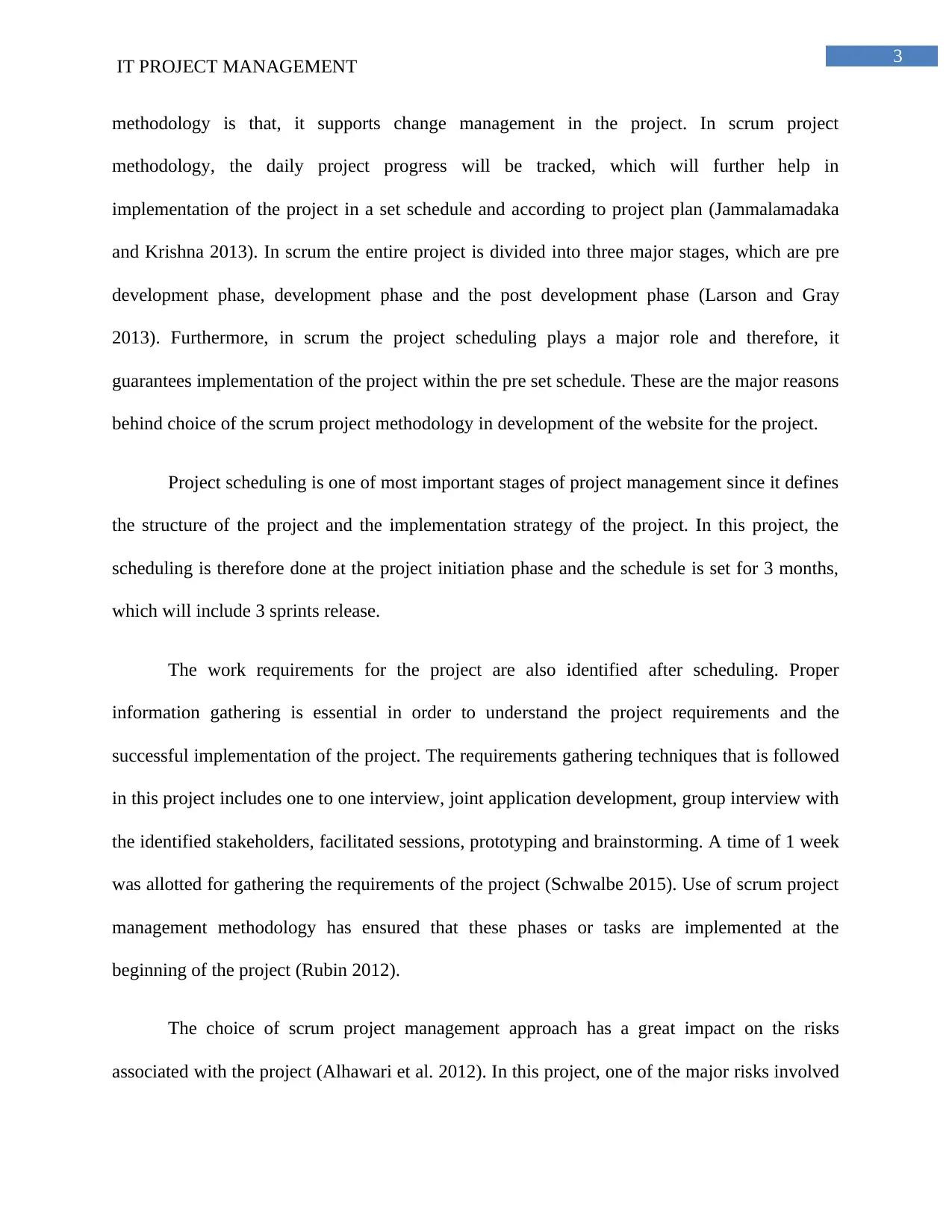
3
IT PROJECT MANAGEMENT
methodology is that, it supports change management in the project. In scrum project
methodology, the daily project progress will be tracked, which will further help in
implementation of the project in a set schedule and according to project plan (Jammalamadaka
and Krishna 2013). In scrum the entire project is divided into three major stages, which are pre
development phase, development phase and the post development phase (Larson and Gray
2013). Furthermore, in scrum the project scheduling plays a major role and therefore, it
guarantees implementation of the project within the pre set schedule. These are the major reasons
behind choice of the scrum project methodology in development of the website for the project.
Project scheduling is one of most important stages of project management since it defines
the structure of the project and the implementation strategy of the project. In this project, the
scheduling is therefore done at the project initiation phase and the schedule is set for 3 months,
which will include 3 sprints release.
The work requirements for the project are also identified after scheduling. Proper
information gathering is essential in order to understand the project requirements and the
successful implementation of the project. The requirements gathering techniques that is followed
in this project includes one to one interview, joint application development, group interview with
the identified stakeholders, facilitated sessions, prototyping and brainstorming. A time of 1 week
was allotted for gathering the requirements of the project (Schwalbe 2015). Use of scrum project
management methodology has ensured that these phases or tasks are implemented at the
beginning of the project (Rubin 2012).
The choice of scrum project management approach has a great impact on the risks
associated with the project (Alhawari et al. 2012). In this project, one of the major risks involved
IT PROJECT MANAGEMENT
methodology is that, it supports change management in the project. In scrum project
methodology, the daily project progress will be tracked, which will further help in
implementation of the project in a set schedule and according to project plan (Jammalamadaka
and Krishna 2013). In scrum the entire project is divided into three major stages, which are pre
development phase, development phase and the post development phase (Larson and Gray
2013). Furthermore, in scrum the project scheduling plays a major role and therefore, it
guarantees implementation of the project within the pre set schedule. These are the major reasons
behind choice of the scrum project methodology in development of the website for the project.
Project scheduling is one of most important stages of project management since it defines
the structure of the project and the implementation strategy of the project. In this project, the
scheduling is therefore done at the project initiation phase and the schedule is set for 3 months,
which will include 3 sprints release.
The work requirements for the project are also identified after scheduling. Proper
information gathering is essential in order to understand the project requirements and the
successful implementation of the project. The requirements gathering techniques that is followed
in this project includes one to one interview, joint application development, group interview with
the identified stakeholders, facilitated sessions, prototyping and brainstorming. A time of 1 week
was allotted for gathering the requirements of the project (Schwalbe 2015). Use of scrum project
management methodology has ensured that these phases or tasks are implemented at the
beginning of the project (Rubin 2012).
The choice of scrum project management approach has a great impact on the risks
associated with the project (Alhawari et al. 2012). In this project, one of the major risks involved
Paraphrase This Document
Need a fresh take? Get an instant paraphrase of this document with our AI Paraphraser
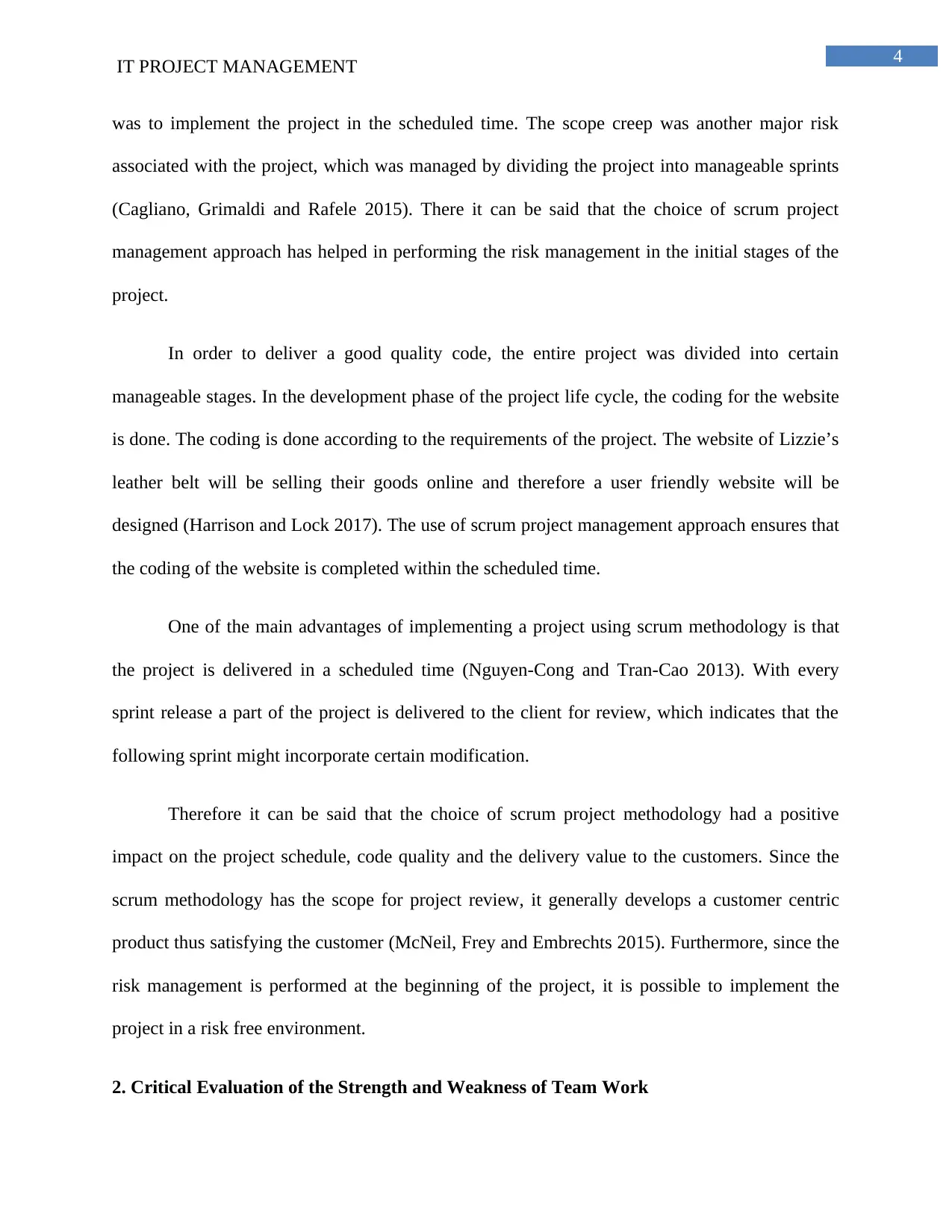
4
IT PROJECT MANAGEMENT
was to implement the project in the scheduled time. The scope creep was another major risk
associated with the project, which was managed by dividing the project into manageable sprints
(Cagliano, Grimaldi and Rafele 2015). There it can be said that the choice of scrum project
management approach has helped in performing the risk management in the initial stages of the
project.
In order to deliver a good quality code, the entire project was divided into certain
manageable stages. In the development phase of the project life cycle, the coding for the website
is done. The coding is done according to the requirements of the project. The website of Lizzie’s
leather belt will be selling their goods online and therefore a user friendly website will be
designed (Harrison and Lock 2017). The use of scrum project management approach ensures that
the coding of the website is completed within the scheduled time.
One of the main advantages of implementing a project using scrum methodology is that
the project is delivered in a scheduled time (Nguyen-Cong and Tran-Cao 2013). With every
sprint release a part of the project is delivered to the client for review, which indicates that the
following sprint might incorporate certain modification.
Therefore it can be said that the choice of scrum project methodology had a positive
impact on the project schedule, code quality and the delivery value to the customers. Since the
scrum methodology has the scope for project review, it generally develops a customer centric
product thus satisfying the customer (McNeil, Frey and Embrechts 2015). Furthermore, since the
risk management is performed at the beginning of the project, it is possible to implement the
project in a risk free environment.
2. Critical Evaluation of the Strength and Weakness of Team Work
IT PROJECT MANAGEMENT
was to implement the project in the scheduled time. The scope creep was another major risk
associated with the project, which was managed by dividing the project into manageable sprints
(Cagliano, Grimaldi and Rafele 2015). There it can be said that the choice of scrum project
management approach has helped in performing the risk management in the initial stages of the
project.
In order to deliver a good quality code, the entire project was divided into certain
manageable stages. In the development phase of the project life cycle, the coding for the website
is done. The coding is done according to the requirements of the project. The website of Lizzie’s
leather belt will be selling their goods online and therefore a user friendly website will be
designed (Harrison and Lock 2017). The use of scrum project management approach ensures that
the coding of the website is completed within the scheduled time.
One of the main advantages of implementing a project using scrum methodology is that
the project is delivered in a scheduled time (Nguyen-Cong and Tran-Cao 2013). With every
sprint release a part of the project is delivered to the client for review, which indicates that the
following sprint might incorporate certain modification.
Therefore it can be said that the choice of scrum project methodology had a positive
impact on the project schedule, code quality and the delivery value to the customers. Since the
scrum methodology has the scope for project review, it generally develops a customer centric
product thus satisfying the customer (McNeil, Frey and Embrechts 2015). Furthermore, since the
risk management is performed at the beginning of the project, it is possible to implement the
project in a risk free environment.
2. Critical Evaluation of the Strength and Weakness of Team Work
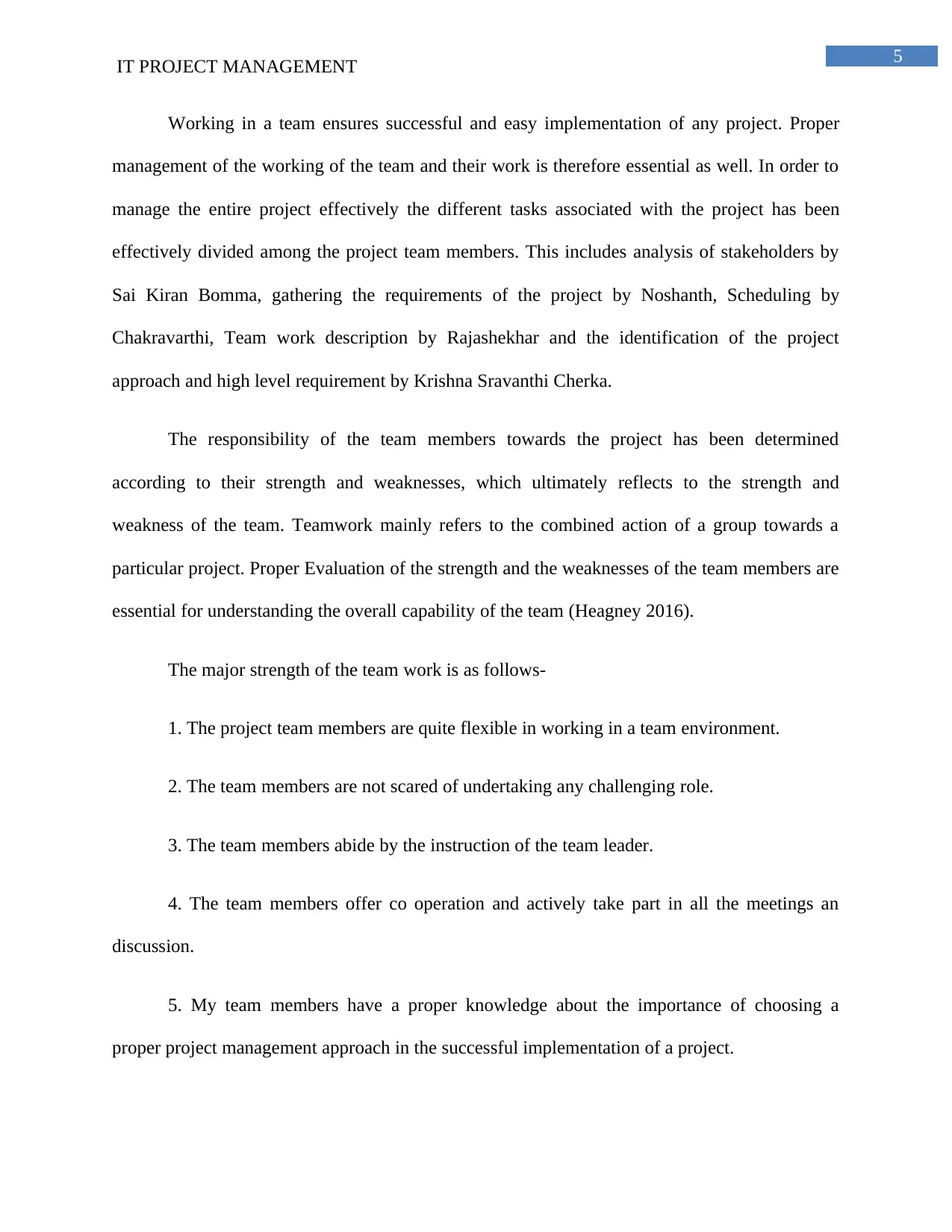
5
IT PROJECT MANAGEMENT
Working in a team ensures successful and easy implementation of any project. Proper
management of the working of the team and their work is therefore essential as well. In order to
manage the entire project effectively the different tasks associated with the project has been
effectively divided among the project team members. This includes analysis of stakeholders by
Sai Kiran Bomma, gathering the requirements of the project by Noshanth, Scheduling by
Chakravarthi, Team work description by Rajashekhar and the identification of the project
approach and high level requirement by Krishna Sravanthi Cherka.
The responsibility of the team members towards the project has been determined
according to their strength and weaknesses, which ultimately reflects to the strength and
weakness of the team. Teamwork mainly refers to the combined action of a group towards a
particular project. Proper Evaluation of the strength and the weaknesses of the team members are
essential for understanding the overall capability of the team (Heagney 2016).
The major strength of the team work is as follows-
1. The project team members are quite flexible in working in a team environment.
2. The team members are not scared of undertaking any challenging role.
3. The team members abide by the instruction of the team leader.
4. The team members offer co operation and actively take part in all the meetings an
discussion.
5. My team members have a proper knowledge about the importance of choosing a
proper project management approach in the successful implementation of a project.
IT PROJECT MANAGEMENT
Working in a team ensures successful and easy implementation of any project. Proper
management of the working of the team and their work is therefore essential as well. In order to
manage the entire project effectively the different tasks associated with the project has been
effectively divided among the project team members. This includes analysis of stakeholders by
Sai Kiran Bomma, gathering the requirements of the project by Noshanth, Scheduling by
Chakravarthi, Team work description by Rajashekhar and the identification of the project
approach and high level requirement by Krishna Sravanthi Cherka.
The responsibility of the team members towards the project has been determined
according to their strength and weaknesses, which ultimately reflects to the strength and
weakness of the team. Teamwork mainly refers to the combined action of a group towards a
particular project. Proper Evaluation of the strength and the weaknesses of the team members are
essential for understanding the overall capability of the team (Heagney 2016).
The major strength of the team work is as follows-
1. The project team members are quite flexible in working in a team environment.
2. The team members are not scared of undertaking any challenging role.
3. The team members abide by the instruction of the team leader.
4. The team members offer co operation and actively take part in all the meetings an
discussion.
5. My team members have a proper knowledge about the importance of choosing a
proper project management approach in the successful implementation of a project.
⊘ This is a preview!⊘
Do you want full access?
Subscribe today to unlock all pages.

Trusted by 1+ million students worldwide
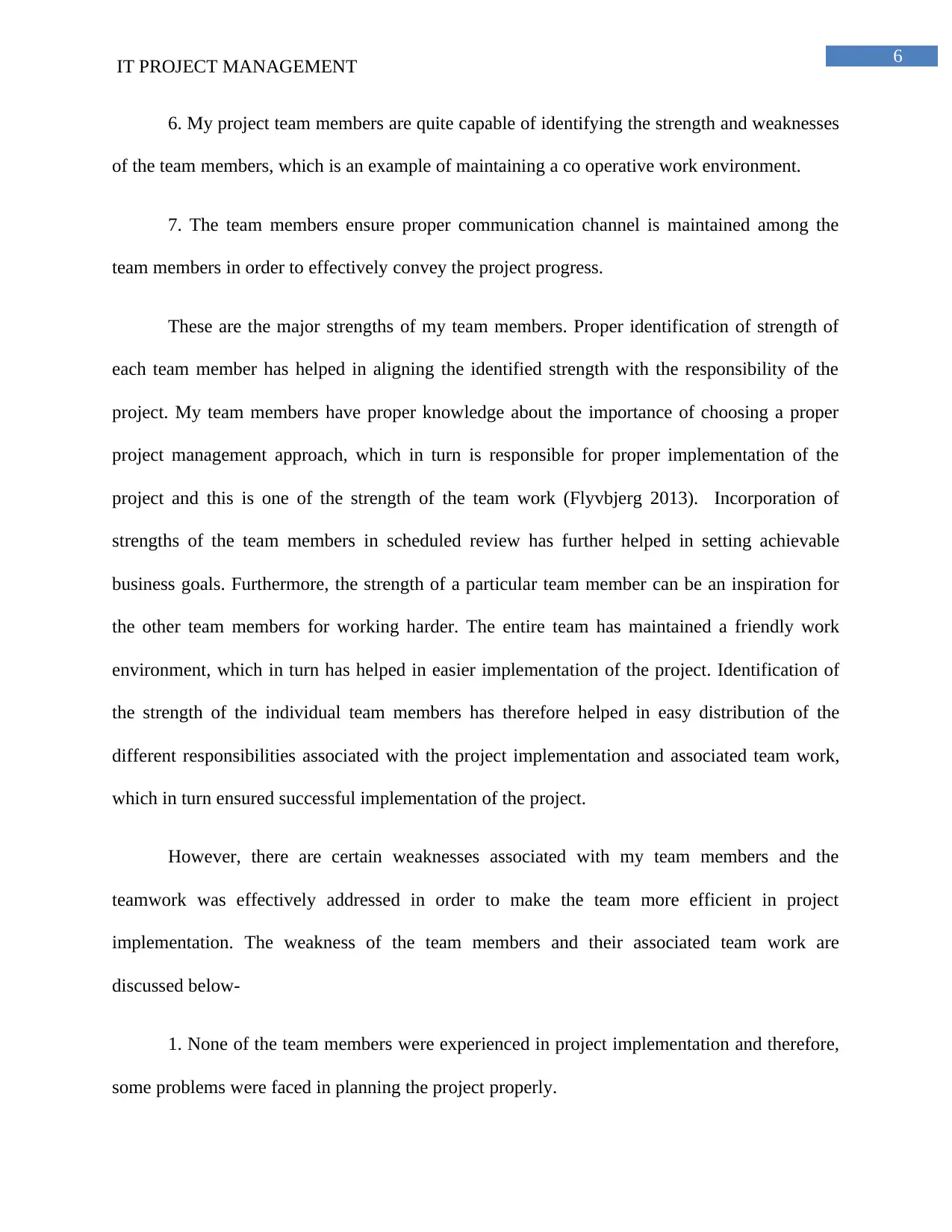
6
IT PROJECT MANAGEMENT
6. My project team members are quite capable of identifying the strength and weaknesses
of the team members, which is an example of maintaining a co operative work environment.
7. The team members ensure proper communication channel is maintained among the
team members in order to effectively convey the project progress.
These are the major strengths of my team members. Proper identification of strength of
each team member has helped in aligning the identified strength with the responsibility of the
project. My team members have proper knowledge about the importance of choosing a proper
project management approach, which in turn is responsible for proper implementation of the
project and this is one of the strength of the team work (Flyvbjerg 2013). Incorporation of
strengths of the team members in scheduled review has further helped in setting achievable
business goals. Furthermore, the strength of a particular team member can be an inspiration for
the other team members for working harder. The entire team has maintained a friendly work
environment, which in turn has helped in easier implementation of the project. Identification of
the strength of the individual team members has therefore helped in easy distribution of the
different responsibilities associated with the project implementation and associated team work,
which in turn ensured successful implementation of the project.
However, there are certain weaknesses associated with my team members and the
teamwork was effectively addressed in order to make the team more efficient in project
implementation. The weakness of the team members and their associated team work are
discussed below-
1. None of the team members were experienced in project implementation and therefore,
some problems were faced in planning the project properly.
IT PROJECT MANAGEMENT
6. My project team members are quite capable of identifying the strength and weaknesses
of the team members, which is an example of maintaining a co operative work environment.
7. The team members ensure proper communication channel is maintained among the
team members in order to effectively convey the project progress.
These are the major strengths of my team members. Proper identification of strength of
each team member has helped in aligning the identified strength with the responsibility of the
project. My team members have proper knowledge about the importance of choosing a proper
project management approach, which in turn is responsible for proper implementation of the
project and this is one of the strength of the team work (Flyvbjerg 2013). Incorporation of
strengths of the team members in scheduled review has further helped in setting achievable
business goals. Furthermore, the strength of a particular team member can be an inspiration for
the other team members for working harder. The entire team has maintained a friendly work
environment, which in turn has helped in easier implementation of the project. Identification of
the strength of the individual team members has therefore helped in easy distribution of the
different responsibilities associated with the project implementation and associated team work,
which in turn ensured successful implementation of the project.
However, there are certain weaknesses associated with my team members and the
teamwork was effectively addressed in order to make the team more efficient in project
implementation. The weakness of the team members and their associated team work are
discussed below-
1. None of the team members were experienced in project implementation and therefore,
some problems were faced in planning the project properly.
Paraphrase This Document
Need a fresh take? Get an instant paraphrase of this document with our AI Paraphraser
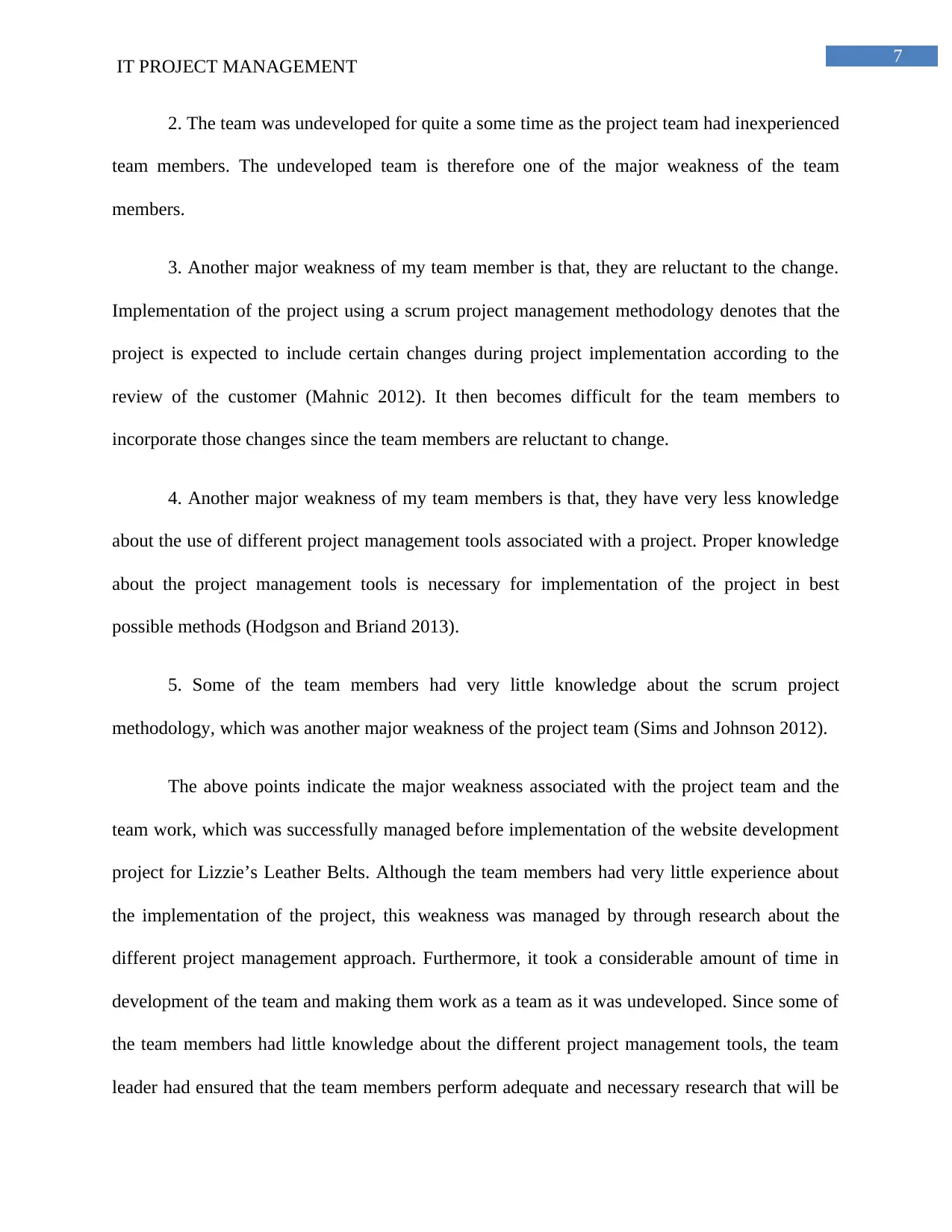
7
IT PROJECT MANAGEMENT
2. The team was undeveloped for quite a some time as the project team had inexperienced
team members. The undeveloped team is therefore one of the major weakness of the team
members.
3. Another major weakness of my team member is that, they are reluctant to the change.
Implementation of the project using a scrum project management methodology denotes that the
project is expected to include certain changes during project implementation according to the
review of the customer (Mahnic 2012). It then becomes difficult for the team members to
incorporate those changes since the team members are reluctant to change.
4. Another major weakness of my team members is that, they have very less knowledge
about the use of different project management tools associated with a project. Proper knowledge
about the project management tools is necessary for implementation of the project in best
possible methods (Hodgson and Briand 2013).
5. Some of the team members had very little knowledge about the scrum project
methodology, which was another major weakness of the project team (Sims and Johnson 2012).
The above points indicate the major weakness associated with the project team and the
team work, which was successfully managed before implementation of the website development
project for Lizzie’s Leather Belts. Although the team members had very little experience about
the implementation of the project, this weakness was managed by through research about the
different project management approach. Furthermore, it took a considerable amount of time in
development of the team and making them work as a team as it was undeveloped. Since some of
the team members had little knowledge about the different project management tools, the team
leader had ensured that the team members perform adequate and necessary research that will be
IT PROJECT MANAGEMENT
2. The team was undeveloped for quite a some time as the project team had inexperienced
team members. The undeveloped team is therefore one of the major weakness of the team
members.
3. Another major weakness of my team member is that, they are reluctant to the change.
Implementation of the project using a scrum project management methodology denotes that the
project is expected to include certain changes during project implementation according to the
review of the customer (Mahnic 2012). It then becomes difficult for the team members to
incorporate those changes since the team members are reluctant to change.
4. Another major weakness of my team members is that, they have very less knowledge
about the use of different project management tools associated with a project. Proper knowledge
about the project management tools is necessary for implementation of the project in best
possible methods (Hodgson and Briand 2013).
5. Some of the team members had very little knowledge about the scrum project
methodology, which was another major weakness of the project team (Sims and Johnson 2012).
The above points indicate the major weakness associated with the project team and the
team work, which was successfully managed before implementation of the website development
project for Lizzie’s Leather Belts. Although the team members had very little experience about
the implementation of the project, this weakness was managed by through research about the
different project management approach. Furthermore, it took a considerable amount of time in
development of the team and making them work as a team as it was undeveloped. Since some of
the team members had little knowledge about the different project management tools, the team
leader had ensured that the team members perform adequate and necessary research that will be
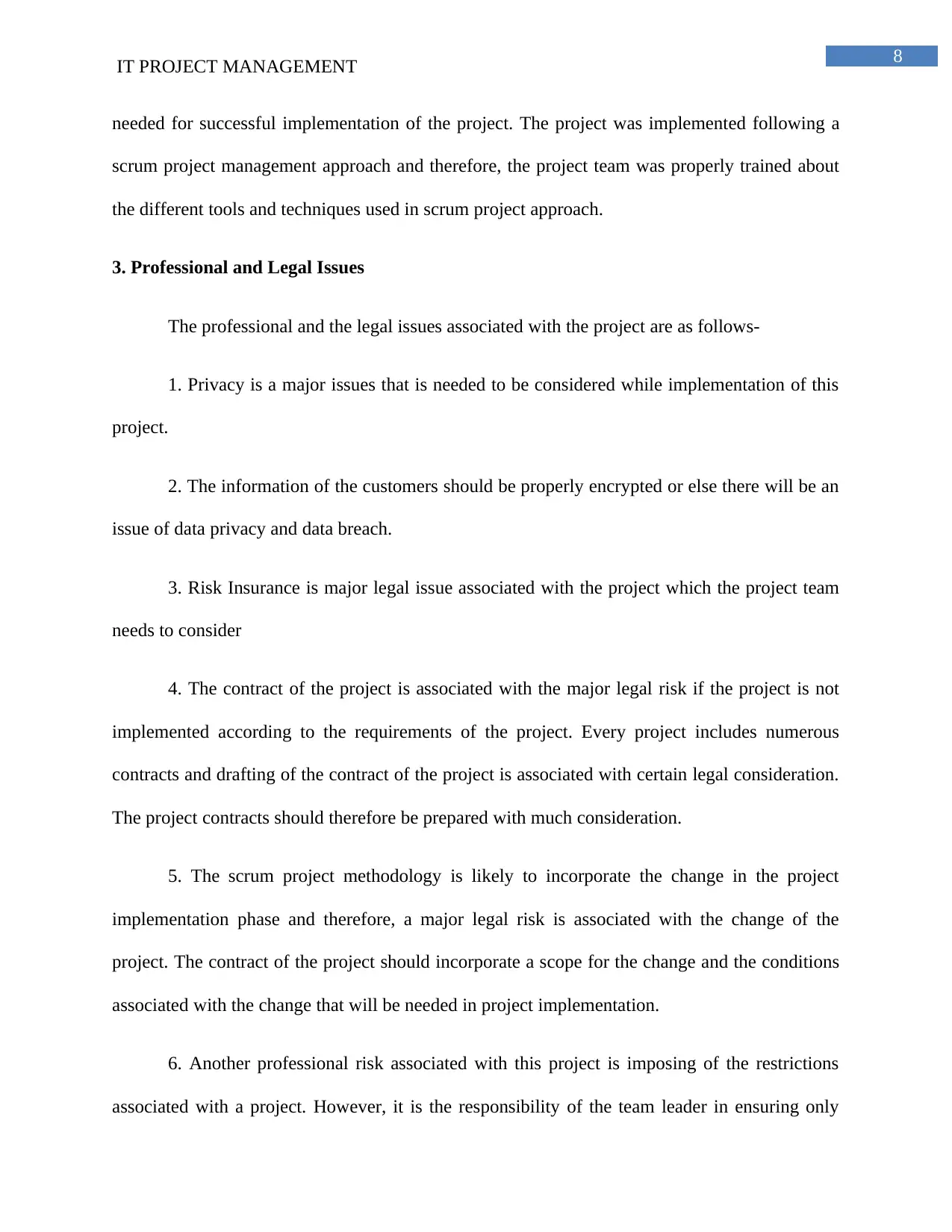
8
IT PROJECT MANAGEMENT
needed for successful implementation of the project. The project was implemented following a
scrum project management approach and therefore, the project team was properly trained about
the different tools and techniques used in scrum project approach.
3. Professional and Legal Issues
The professional and the legal issues associated with the project are as follows-
1. Privacy is a major issues that is needed to be considered while implementation of this
project.
2. The information of the customers should be properly encrypted or else there will be an
issue of data privacy and data breach.
3. Risk Insurance is major legal issue associated with the project which the project team
needs to consider
4. The contract of the project is associated with the major legal risk if the project is not
implemented according to the requirements of the project. Every project includes numerous
contracts and drafting of the contract of the project is associated with certain legal consideration.
The project contracts should therefore be prepared with much consideration.
5. The scrum project methodology is likely to incorporate the change in the project
implementation phase and therefore, a major legal risk is associated with the change of the
project. The contract of the project should incorporate a scope for the change and the conditions
associated with the change that will be needed in project implementation.
6. Another professional risk associated with this project is imposing of the restrictions
associated with a project. However, it is the responsibility of the team leader in ensuring only
IT PROJECT MANAGEMENT
needed for successful implementation of the project. The project was implemented following a
scrum project management approach and therefore, the project team was properly trained about
the different tools and techniques used in scrum project approach.
3. Professional and Legal Issues
The professional and the legal issues associated with the project are as follows-
1. Privacy is a major issues that is needed to be considered while implementation of this
project.
2. The information of the customers should be properly encrypted or else there will be an
issue of data privacy and data breach.
3. Risk Insurance is major legal issue associated with the project which the project team
needs to consider
4. The contract of the project is associated with the major legal risk if the project is not
implemented according to the requirements of the project. Every project includes numerous
contracts and drafting of the contract of the project is associated with certain legal consideration.
The project contracts should therefore be prepared with much consideration.
5. The scrum project methodology is likely to incorporate the change in the project
implementation phase and therefore, a major legal risk is associated with the change of the
project. The contract of the project should incorporate a scope for the change and the conditions
associated with the change that will be needed in project implementation.
6. Another professional risk associated with this project is imposing of the restrictions
associated with a project. However, it is the responsibility of the team leader in ensuring only
⊘ This is a preview!⊘
Do you want full access?
Subscribe today to unlock all pages.

Trusted by 1+ million students worldwide
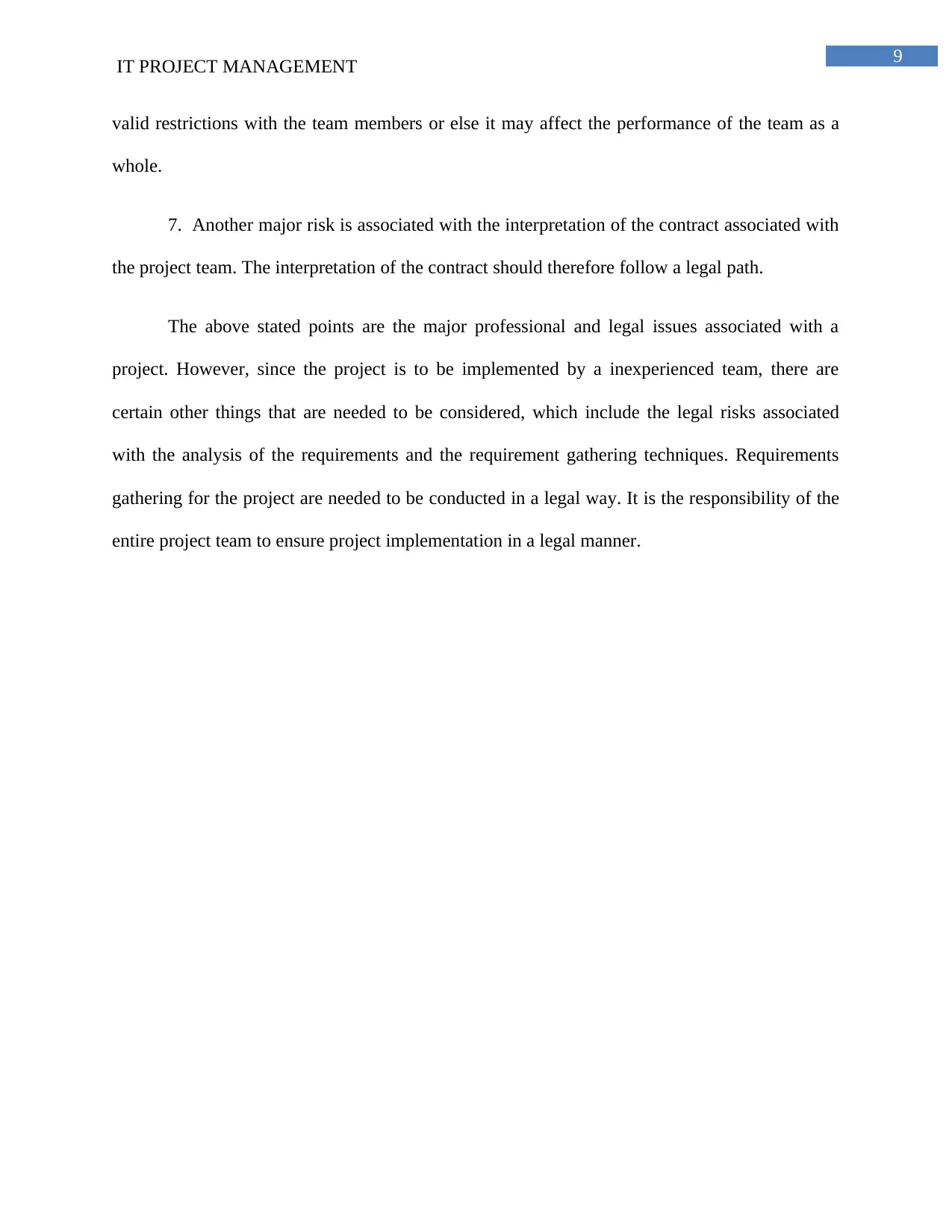
9
IT PROJECT MANAGEMENT
valid restrictions with the team members or else it may affect the performance of the team as a
whole.
7. Another major risk is associated with the interpretation of the contract associated with
the project team. The interpretation of the contract should therefore follow a legal path.
The above stated points are the major professional and legal issues associated with a
project. However, since the project is to be implemented by a inexperienced team, there are
certain other things that are needed to be considered, which include the legal risks associated
with the analysis of the requirements and the requirement gathering techniques. Requirements
gathering for the project are needed to be conducted in a legal way. It is the responsibility of the
entire project team to ensure project implementation in a legal manner.
IT PROJECT MANAGEMENT
valid restrictions with the team members or else it may affect the performance of the team as a
whole.
7. Another major risk is associated with the interpretation of the contract associated with
the project team. The interpretation of the contract should therefore follow a legal path.
The above stated points are the major professional and legal issues associated with a
project. However, since the project is to be implemented by a inexperienced team, there are
certain other things that are needed to be considered, which include the legal risks associated
with the analysis of the requirements and the requirement gathering techniques. Requirements
gathering for the project are needed to be conducted in a legal way. It is the responsibility of the
entire project team to ensure project implementation in a legal manner.
Paraphrase This Document
Need a fresh take? Get an instant paraphrase of this document with our AI Paraphraser
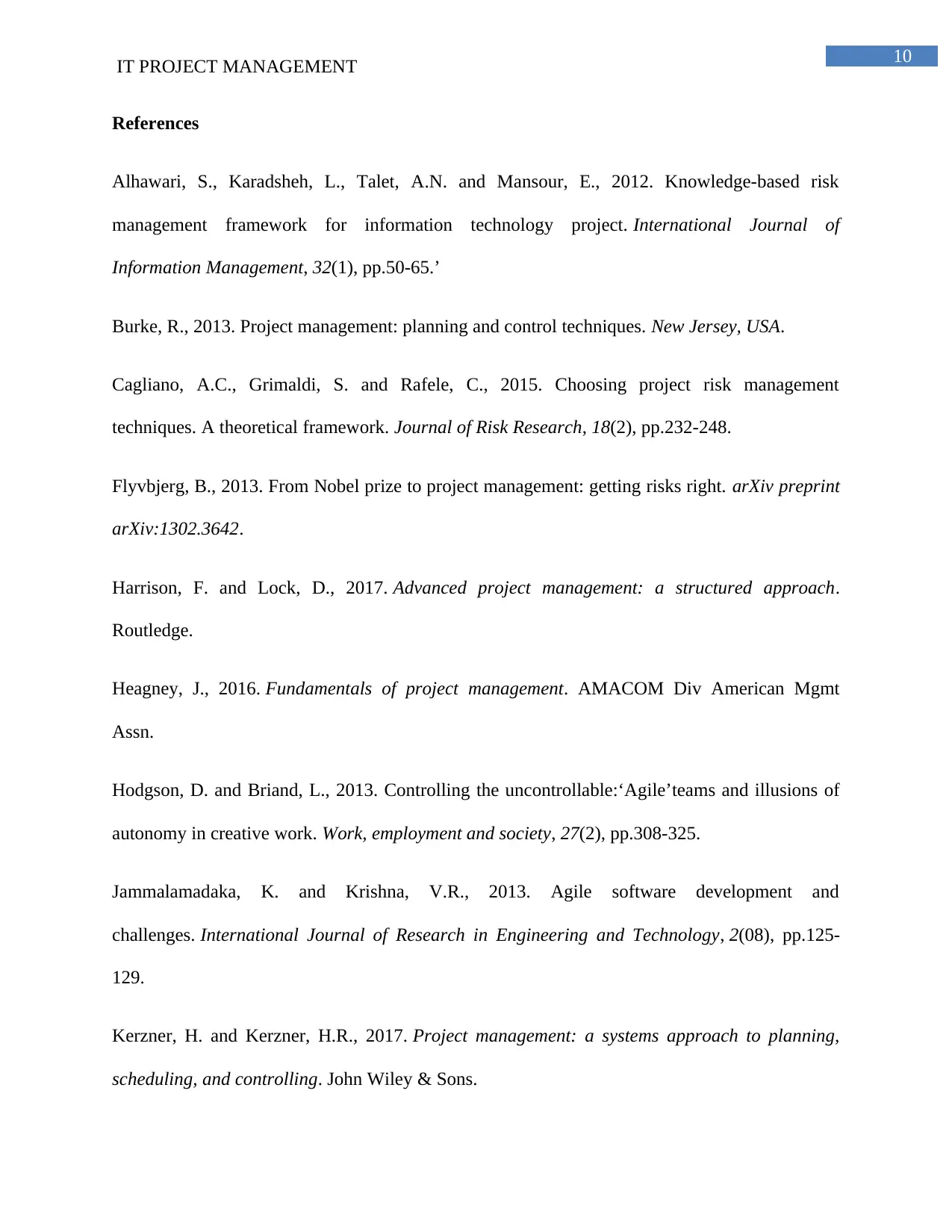
10
IT PROJECT MANAGEMENT
References
Alhawari, S., Karadsheh, L., Talet, A.N. and Mansour, E., 2012. Knowledge-based risk
management framework for information technology project. International Journal of
Information Management, 32(1), pp.50-65.’
Burke, R., 2013. Project management: planning and control techniques. New Jersey, USA.
Cagliano, A.C., Grimaldi, S. and Rafele, C., 2015. Choosing project risk management
techniques. A theoretical framework. Journal of Risk Research, 18(2), pp.232-248.
Flyvbjerg, B., 2013. From Nobel prize to project management: getting risks right. arXiv preprint
arXiv:1302.3642.
Harrison, F. and Lock, D., 2017. Advanced project management: a structured approach.
Routledge.
Heagney, J., 2016. Fundamentals of project management. AMACOM Div American Mgmt
Assn.
Hodgson, D. and Briand, L., 2013. Controlling the uncontrollable:‘Agile’teams and illusions of
autonomy in creative work. Work, employment and society, 27(2), pp.308-325.
Jammalamadaka, K. and Krishna, V.R., 2013. Agile software development and
challenges. International Journal of Research in Engineering and Technology, 2(08), pp.125-
129.
Kerzner, H. and Kerzner, H.R., 2017. Project management: a systems approach to planning,
scheduling, and controlling. John Wiley & Sons.
IT PROJECT MANAGEMENT
References
Alhawari, S., Karadsheh, L., Talet, A.N. and Mansour, E., 2012. Knowledge-based risk
management framework for information technology project. International Journal of
Information Management, 32(1), pp.50-65.’
Burke, R., 2013. Project management: planning and control techniques. New Jersey, USA.
Cagliano, A.C., Grimaldi, S. and Rafele, C., 2015. Choosing project risk management
techniques. A theoretical framework. Journal of Risk Research, 18(2), pp.232-248.
Flyvbjerg, B., 2013. From Nobel prize to project management: getting risks right. arXiv preprint
arXiv:1302.3642.
Harrison, F. and Lock, D., 2017. Advanced project management: a structured approach.
Routledge.
Heagney, J., 2016. Fundamentals of project management. AMACOM Div American Mgmt
Assn.
Hodgson, D. and Briand, L., 2013. Controlling the uncontrollable:‘Agile’teams and illusions of
autonomy in creative work. Work, employment and society, 27(2), pp.308-325.
Jammalamadaka, K. and Krishna, V.R., 2013. Agile software development and
challenges. International Journal of Research in Engineering and Technology, 2(08), pp.125-
129.
Kerzner, H. and Kerzner, H.R., 2017. Project management: a systems approach to planning,
scheduling, and controlling. John Wiley & Sons.
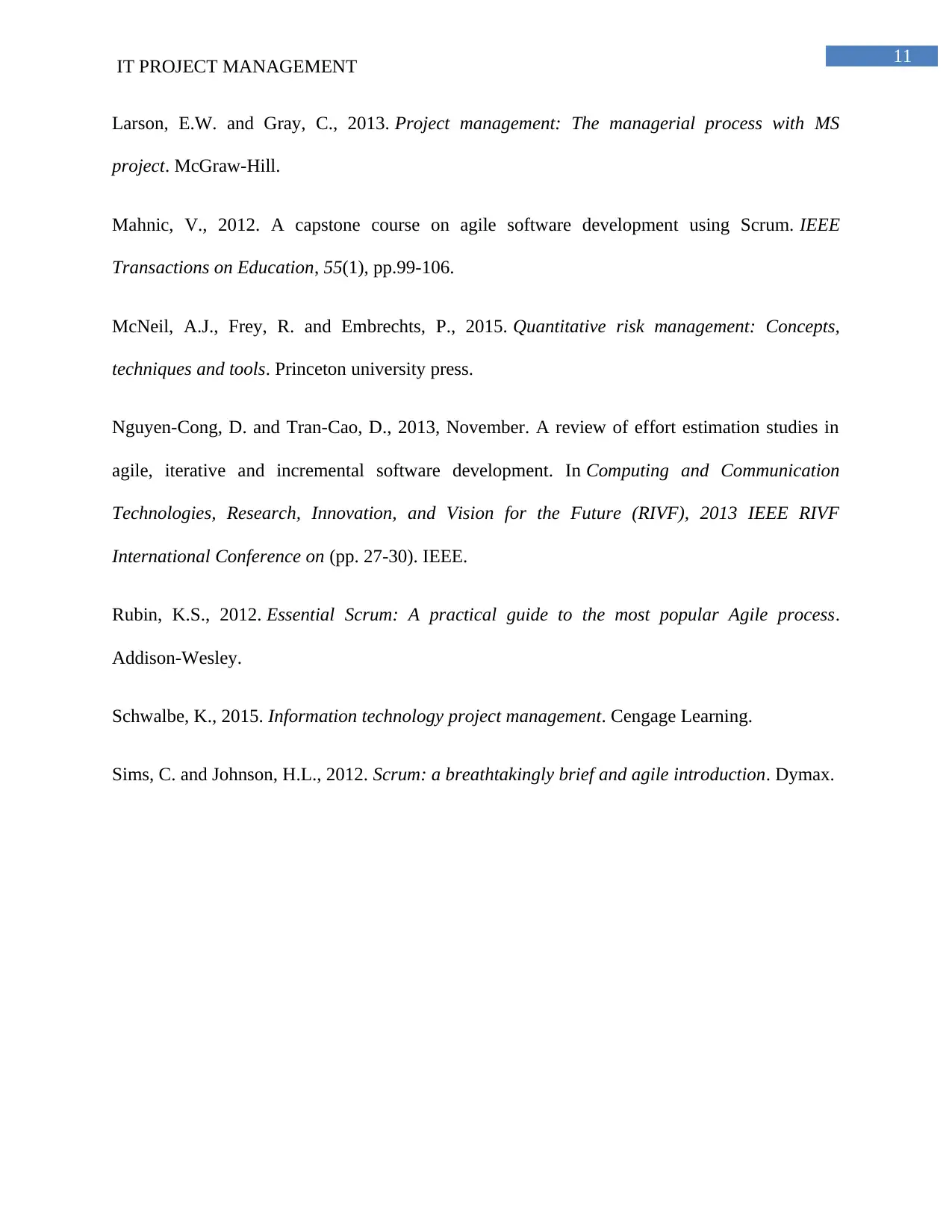
11
IT PROJECT MANAGEMENT
Larson, E.W. and Gray, C., 2013. Project management: The managerial process with MS
project. McGraw-Hill.
Mahnic, V., 2012. A capstone course on agile software development using Scrum. IEEE
Transactions on Education, 55(1), pp.99-106.
McNeil, A.J., Frey, R. and Embrechts, P., 2015. Quantitative risk management: Concepts,
techniques and tools. Princeton university press.
Nguyen-Cong, D. and Tran-Cao, D., 2013, November. A review of effort estimation studies in
agile, iterative and incremental software development. In Computing and Communication
Technologies, Research, Innovation, and Vision for the Future (RIVF), 2013 IEEE RIVF
International Conference on (pp. 27-30). IEEE.
Rubin, K.S., 2012. Essential Scrum: A practical guide to the most popular Agile process.
Addison-Wesley.
Schwalbe, K., 2015. Information technology project management. Cengage Learning.
Sims, C. and Johnson, H.L., 2012. Scrum: a breathtakingly brief and agile introduction. Dymax.
IT PROJECT MANAGEMENT
Larson, E.W. and Gray, C., 2013. Project management: The managerial process with MS
project. McGraw-Hill.
Mahnic, V., 2012. A capstone course on agile software development using Scrum. IEEE
Transactions on Education, 55(1), pp.99-106.
McNeil, A.J., Frey, R. and Embrechts, P., 2015. Quantitative risk management: Concepts,
techniques and tools. Princeton university press.
Nguyen-Cong, D. and Tran-Cao, D., 2013, November. A review of effort estimation studies in
agile, iterative and incremental software development. In Computing and Communication
Technologies, Research, Innovation, and Vision for the Future (RIVF), 2013 IEEE RIVF
International Conference on (pp. 27-30). IEEE.
Rubin, K.S., 2012. Essential Scrum: A practical guide to the most popular Agile process.
Addison-Wesley.
Schwalbe, K., 2015. Information technology project management. Cengage Learning.
Sims, C. and Johnson, H.L., 2012. Scrum: a breathtakingly brief and agile introduction. Dymax.
⊘ This is a preview!⊘
Do you want full access?
Subscribe today to unlock all pages.

Trusted by 1+ million students worldwide
1 out of 12
Related Documents
Your All-in-One AI-Powered Toolkit for Academic Success.
+13062052269
info@desklib.com
Available 24*7 on WhatsApp / Email
![[object Object]](/_next/static/media/star-bottom.7253800d.svg)
Unlock your academic potential
Copyright © 2020–2025 A2Z Services. All Rights Reserved. Developed and managed by ZUCOL.




